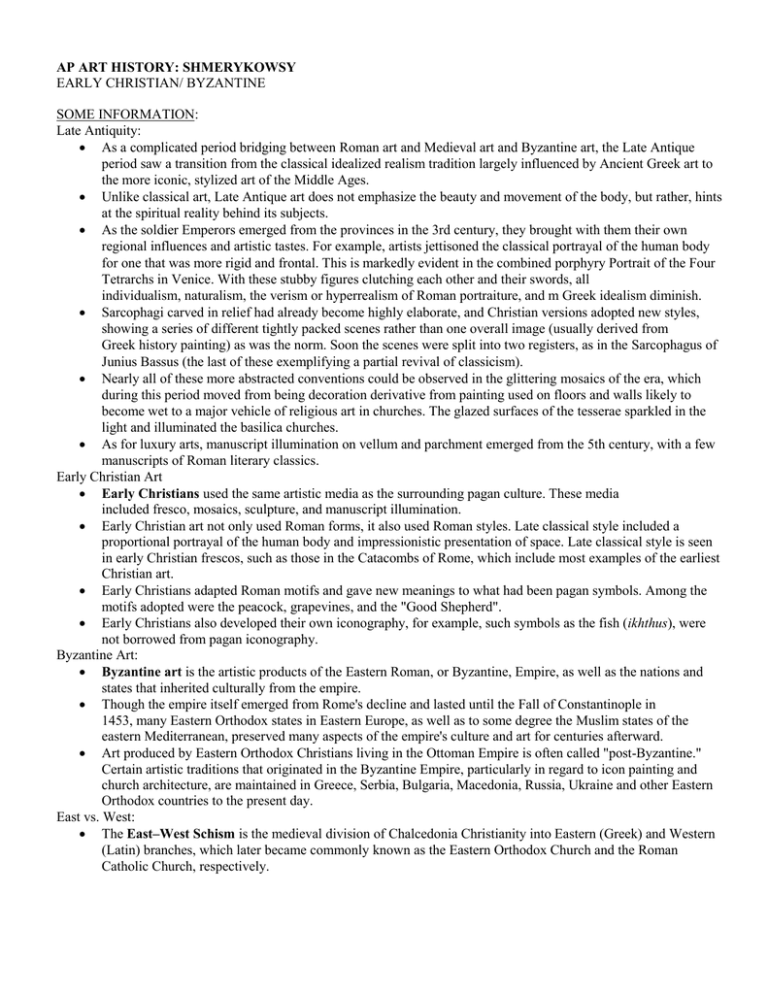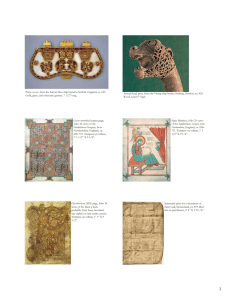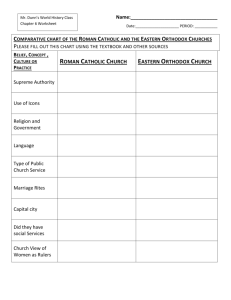AP ART HISTORY: SHMERYKOWSY EARLY CHRISTIAN/ BYZANTINE SOME INFORMATION:
advertisement

AP ART HISTORY: SHMERYKOWSY EARLY CHRISTIAN/ BYZANTINE SOME INFORMATION: Late Antiquity: As a complicated period bridging between Roman art and Medieval art and Byzantine art, the Late Antique period saw a transition from the classical idealized realism tradition largely influenced by Ancient Greek art to the more iconic, stylized art of the Middle Ages. Unlike classical art, Late Antique art does not emphasize the beauty and movement of the body, but rather, hints at the spiritual reality behind its subjects. As the soldier Emperors emerged from the provinces in the 3rd century, they brought with them their own regional influences and artistic tastes. For example, artists jettisoned the classical portrayal of the human body for one that was more rigid and frontal. This is markedly evident in the combined porphyry Portrait of the Four Tetrarchs in Venice. With these stubby figures clutching each other and their swords, all individualism, naturalism, the verism or hyperrealism of Roman portraiture, and m Greek idealism diminish. Sarcophagi carved in relief had already become highly elaborate, and Christian versions adopted new styles, showing a series of different tightly packed scenes rather than one overall image (usually derived from Greek history painting) as was the norm. Soon the scenes were split into two registers, as in the Sarcophagus of Junius Bassus (the last of these exemplifying a partial revival of classicism). Nearly all of these more abstracted conventions could be observed in the glittering mosaics of the era, which during this period moved from being decoration derivative from painting used on floors and walls likely to become wet to a major vehicle of religious art in churches. The glazed surfaces of the tesserae sparkled in the light and illuminated the basilica churches. As for luxury arts, manuscript illumination on vellum and parchment emerged from the 5th century, with a few manuscripts of Roman literary classics. Early Christian Art Early Christians used the same artistic media as the surrounding pagan culture. These media included fresco, mosaics, sculpture, and manuscript illumination. Early Christian art not only used Roman forms, it also used Roman styles. Late classical style included a proportional portrayal of the human body and impressionistic presentation of space. Late classical style is seen in early Christian frescos, such as those in the Catacombs of Rome, which include most examples of the earliest Christian art. Early Christians adapted Roman motifs and gave new meanings to what had been pagan symbols. Among the motifs adopted were the peacock, grapevines, and the "Good Shepherd". Early Christians also developed their own iconography, for example, such symbols as the fish (ikhthus), were not borrowed from pagan iconography. Byzantine Art: Byzantine art is the artistic products of the Eastern Roman, or Byzantine, Empire, as well as the nations and states that inherited culturally from the empire. Though the empire itself emerged from Rome's decline and lasted until the Fall of Constantinople in 1453, many Eastern Orthodox states in Eastern Europe, as well as to some degree the Muslim states of the eastern Mediterranean, preserved many aspects of the empire's culture and art for centuries afterward. Art produced by Eastern Orthodox Christians living in the Ottoman Empire is often called "post-Byzantine." Certain artistic traditions that originated in the Byzantine Empire, particularly in regard to icon painting and church architecture, are maintained in Greece, Serbia, Bulgaria, Macedonia, Russia, Ukraine and other Eastern Orthodox countries to the present day. East vs. West: The East–West Schism is the medieval division of Chalcedonia Christianity into Eastern (Greek) and Western (Latin) branches, which later became commonly known as the Eastern Orthodox Church and the Roman Catholic Church, respectively. OLD SAINT PETER BASCILICA begun 319, 320-327CE atrium added later 4th century erected by Constantine: first imperial patriot of Christianity stood on stop of St. Peters grave CHURCH OF SAINT VITALE Ravenna under construction from 520CE mosaics 546-548CE central domed octagon extended by excedra (semi circular bays) ambulatory: passage, walkway around the apse rectangular sanctuary and semicircular apse dome rests on 8 SQUINCHES (arch or lintel built across the upper corners of a square space) tesserae: small pieces of stone, glass or other materials for mosaics narthex: vestibule or entrance porch of church HAGIA SOPHIA means “Holy Wisdom” replaced after 4th century after destroyed rebuilt under JUSTINIAN chose two scholar theoreticians: ANTHEMIUS OF TRALLES and ISODORUS OF MILETUS to rebuild ANTHEMEIUS specialist in geometry and optics ISIDORUS a specialist in physics and studies vaulting took mortal builders 5 years (532-537) based on central plan with dome inscribed in square shape longitudinal nave with half domes expanding outward from central dome to connect to narthex Main dome supported on PENDENTIVES (triangular curving vault sections) two half domes flank the main dome has 40 windows around the base of the dome Dome design favored by Eastern Church SAN MARCO begun 1063 cuniform ground plan Five domed Apostoleion served as a model for renovations in 10th century TAJ MAHAL “crown of palaces” white marble mausoleum in India base, dome, minaret (meaning lighthouse: tell spiral/ onion shaped conical crown) BARMA AND POSTNIK Cathedral of Saint Basil the Blessed, Moscow Mid 16th century exterior originally painted white and domes golden color added later and names changed originally dedicated to Intercession of Virgin Mary: a reflection of veneration of Mary in Eastern Church DEEIS mosaic south of gallery in HAGIA SOPHIA, Constantinople 1260 commissioned for the retaking of the city rendered in high detail and naturalism VIRGIN AND CHILD FLANKED BY JUSTINIAN I AND CONSTANTINE I 944CE throne without back, feet on pedestal Christ on lap, hand in blessing, other holding scroll RIGHT: Constantine presenting model of city to Mary with inscription” Great Emperor Constantine om the Saints” LEFT: Justinian offering model of Hagia Sophia Medallions on both sides of Virgins head carry MONOGRAMS MP and OX (abbreviations of “Mater” and “Theou”) Mother of God CRUCIFIXION mosaic in East Wall of CHURCH OF DORMITION, Daphni, Greece Late 14th century Jesus barely dressed and flanked by Mary and apostle John by feet: blood and water represent EUCHARIST and BAPTISM PANTOKRAT= Byzantine depiction of Christ as universal ruler CHRIST PANTOKRATER mosaic in central dome of CHURCH OF DORMITION, Daphni Greece 1080-1100 CE combined two persons of Holy trinity in portrayal ◦ father and son ◦ judge and savior ENTHRONED MADONNA AND CHILD mid to late 13th century E typical Byzantine style CHRYSOGRAPHY: art of writing letters in gold tempera on panel VIRGIN OF VLADIMIR probably originally from Constantinople 12th century (faces), rest has been retouched tempera panel brought to Kiev, Ukraine and Kievan Rus people learned and study art form distinctive humanization of Mary and Christ Known as Virgin of Compassion Arrived in Kiev in 1131-1136 and taken by Russia in 1480. ANASTASIS painting in apse of funerary chapel Church of the Monastery of Christinchova Christ as savior in white EMPERIOR JUSTINTIAN AND HIS ATTENDANTS mosaic in North wall of apse Church of Vitale Ravenna, 547 CHI RO: monogram of Greek letters standing for “Christ” combined imperial ritual, Old testament narrative and Christian liturgical symbolism EMPERRESS THEORDRA AND HER ATTENDANCRS Mosaic on SOUCH wall of apse St. Vitale Church, 547 classical illusionist devices suggests richness of the Byzantine court CARPET PAGE WITH CRISS Illustration from LINDISFRANE GOSPELS 710-725 CE orderly division and symmetry govern entire page exuberance of Irish ornament BOOK OF KELLS illuminated manuscripts zoomorphic and anthropomorphic imagery PAGES OF FOUR EVANGELISTS 710-725 ◦ MATTEW= angel ◦ MARK= winged lion ◦ LUKE= ox ◦ JOHN= eagle ARREST OF CHRIST (Book of Kells) ◦ 710-725/ 9th century ◦ CHI RHO MONOGRAM PAGE (book of Kells) ◦ CHI= X ◦ RHHO= P ◦ Irish ornamental style 710-725CE SYMBOL OF MARK Illustration of the GOSPELS OF SAINT WILLIBROID (ECHTERNACH GOSPELS) 690CE imagio leonis: earl Irish art of a free, flamboyant form of herodic beast PAGE WITH REBECCA AT THE WELL from BOOK OF GENSIS (Vienna) Early 6th century CE tempera, gold, silver paint on purple dyed vellum purple dye= shells of murex mollusks Illustrations appear in SINGLE SCENE: events from different times and placed in ONE scene STORY OF JACOB in VIENNA, BOOK OF GENESIS 6th century single narrative with multiple places and time frames SAINT MARK Illustration in GOSPEL BOOK OF EBBO author in bulky mantel, seated frontally, sketchy landscape tiny lion in upper right= INPSIRED EVENGALIST lion= symbol of mystical revelation PAGE WITH MARK THE EVANGELISTSBOOK OF MARK, GODESCALC EVANGELISTARY 781-783 CE ink, gold, colors on vellum small halved lion in upper left corner: inspiration and iconographic symbolic modeled arms, hips, knees beneath garment hint of 3D space PAGE WITH MATTHEW THE EVANGELISTARY BOOK OF MATTHEW 2nd quarter of 9th century ink, gold, colors on vellum Medieval expressionism: less physical appearance but more internal spiritual excitement SAINT MATTHEW Illustration in LINDISFRANE GOSPELS natural proportioned elder background not painted, but drapery conceals witness St. Matthew is receiving divine works which inspire his Gospel Above: bust of his symbolized by winged man (imagio hominis) INITIAL R WITH KNIGHT FIGHTING DRAGONS folio 4 verso of the MORALIA IN JOB from Citeaux, France 1115-1125 CE ink, tempera on vellum ornamental initials SAINT MATTHEW Illustration in the CORONATION GOSPELS Also known as SCHATZKANMER GOSPELS) Early 9th Century classical in style purple stained parchment and silver text monumentality of halo and figure: a serene portrait







